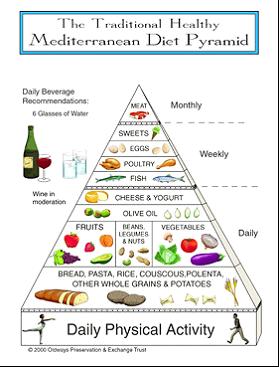Dr. MJ Bazos MD,
Patient
Handout
The
Mediterranean Diet Pyramid
This pyramid, representing a healthy,
traditional Mediterranean diet, is based on the dietary traditions of Crete,
much of the rest of Greece and southern Italy circa 1960, structured in light of
current nutrition research. The selection of these regions and this time period
as a basis for the design follows from three considerations:
- Recognition that the rates of chronic diseases
were among the lowest in the world and adult life expectancy was among the
highest for these populations at that time, even though medical services were
limited;
- Availability of data describing the character of
food consumption patterns of the areas at that time; and
- The convergence of the dietary patterns revealed
by these data and our current understanding of optimal nutrition based on
epidemiological studies and clinical trials worldwide.
Variations of this diet have
traditionally existed in other parts of Italy, parts of Spain and Portugal,
southern France, parts of North Africa (especially Morocco and Tunisia), parts
of Turkey, other parts of the Balkan region, as well as parts of the Middle East
(especially Lebanon and Syria). The diet is closely tied traditionally to areas
of olive oil cultivation in the Mediterranean region.
Given these carefully-defined parameters of
geography and time, the phrase traditional Mediterranean diet is used here as
shorthand for the healthy traditional diets of these regions at that time.
The design of the pyramid is not based solely on
either the weight or the percentage of energy (calories) that foods account for
in the diet, but on a blend of these that is meant to give relative proportions
and a general sense of frequency of servings, as well as an indication of which
foods to favor in a healthy Mediterranean-style diet. The pyramid describes a
diet for most healthy adults. Whether changes would need to be made for
children, women in the reproductive years, and other special population groups
is an issue that needs further consideration.
A principal objective of this graphic
illustration is to foster a dialogue within the international scientific, public
health, food and agricultural, governmental and other communities as to what
specific elements and configuration of the traditional diets of the
Mediterranean should be regarded as healthful.
For Americans, northern and eastern Europeans
and others who want to improve their diets, this model provides a highly
palatable, healthful framework for change. Equally positive results can be
obtained either by entirely adopting a Mediterranean-style diet, or by
alternating meals based on this Mediterranean model with meals inspired by
healthful dietary traditions of other cultures in other parts of the world. For
those living in the Mediterranean region, this pyramid provides a basis for
preserving and revitalizing, within a modern lifestyle, centuries-old traditions
that contribute to excellent health and a sense of pleasure and well-being that
are a vital part of our collective cultural heritage.
This pyramid was the first in a series in
development to illustrate geographically the healthy traditional food and
dietary patterns of various cultures and regions of the world. This initiative
is an outgrowth of a multiyear conference series, "Public Health Implications of
Traditional Diets," jointly organized by Harvard School of Public Health, a
United Nations World Health Organization/Food and Agriculture Organization
(WHO/FAO) Collaborating Center, and Oldways Preservation & Exchange Trust.
These pyramids, taken as a collection, offer substantive refinements of the
United States Department of Agriculture's Food Guide Pyramid, refinements that
reflect the current state of clinical and epidemiological research worldwide and
our understanding of what constitutes optimal human nutrition status.
Diet
Characteristics
Dietary data from those parts of the
Mediterranean region that in the recent past enjoyed the lowest recorded rates
of chronic diseases and the highest adult life expectancy show a pattern like
the one illustrated in the list below. The healthfulness of this pattern is
corroborated by epidemiological and experimental nutrition research. The average
amounts given are in most cases intentionally nonspecific, since variation is
known to have been considerable within this pattern. The historical pattern
includes the following (with several parenthetical notes adding contemporary
public health perspective):
1. An abundance of food from plant sources,
including fruits and vegetables, potatoes, breads and grains,
beans,nuts,and-seeds;
2. Emphasis on a
variety of minimally processed and, wherever possible, seasonally fresh and
locally grown foods (which often maximizes the health-promoting micronutrient
and antioxidant content of these foods);
3. Olive oil as the principal fat,
replacing other fats and oils-(including-butter-and-margarine);
4. Total fat ranging from less than 25
percent to over 35 percent of energy, with saturated fat no more than 7 to
8-percent-of-energy-(calories);
5. Daily
consumption of low to moderate amounts of cheese and yogurt (low-fat and non fat
versions may be preferable);
6. Weekly
consumption of low to moderate amounts of fish and poultry (recent research
suggests that fish be somewhat favored over poultry); from zero to four eggs per
week (including those used in cooking and baking);
7. Fresh fruit as the typical daily
dessert; sweets with a significant amount of sugar (often as honey) and
saturated fat consumed not more than a few times per week;
8. Red meat a few times per month (recent
research suggests that if red meat is eaten, its consumption should be limited
to a maximum of 12 to 16 ounces {340 to 450 grams} per month; where the flavor
is acceptable, lean-versions-may-be-preferable);
9. Regular physical activity at a level
which promotes a healthy weight, fitness and well-being; and
10. Moderate consumption of wine, normally
with meals; about one to two glasses per day for men and one glass per day for
women (from a contemporary public health perspective, wine should be considered
optional and avoided when consumption would put the individual or others at
risk.)

